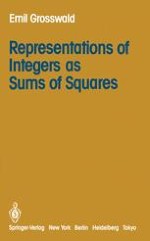1985 | OriginalPaper | Buchkapitel
The Circle Method
verfasst von : Emil Grosswald
Erschienen in: Representations of Integers as Sums of Squares
Verlag: Springer New York
Enthalten in: Professional Book Archive
Aktivieren Sie unsere intelligente Suche, um passende Fachinhalte oder Patente zu finden.
Wählen Sie Textabschnitte aus um mit Künstlicher Intelligenz passenden Patente zu finden. powered by
Markieren Sie Textabschnitte, um KI-gestützt weitere passende Inhalte zu finden. powered by
We mentioned in Chapter 1 that the number r s (n) of solutions of the Diophantine equation (12.1)$$ \sum\limits_{{k = 1}}^s {x_i^2} = n $$ is the coefficient of xn in the Taylor expansion of the function $$ 1 + \sum\nolimits_{{n = 1}}^{\infty } {{r_s}(n){x^n}} $$. Here, as in Chapter 8, we write θ(x) for θ3(1;x) and we shall suppress the first entry, which will always be z = 1. From (12.1); it follows, by Cauchy’s theorem, that (12.2)$$ {r_s}(n) = \frac{1}{{2\pi i}}\int\limits_c {{x^{{ - n - 1}}}{\theta^s}(x)dx,} $$ where, we recall, (12.3)$$ \theta (x) = \sum\limits_{{ - \infty }}^{\infty } {{x^{{{n^2}}}}} = 1 + 2\sum\limits_{{n = 1}}^{\infty } {{x^{{{n^2}}}}} = \sum\limits_{{k = 0}}^{\infty } {{a_k}{x^k},\quad say,} $$ and ?? is a sufficiently small circle around the origin.
